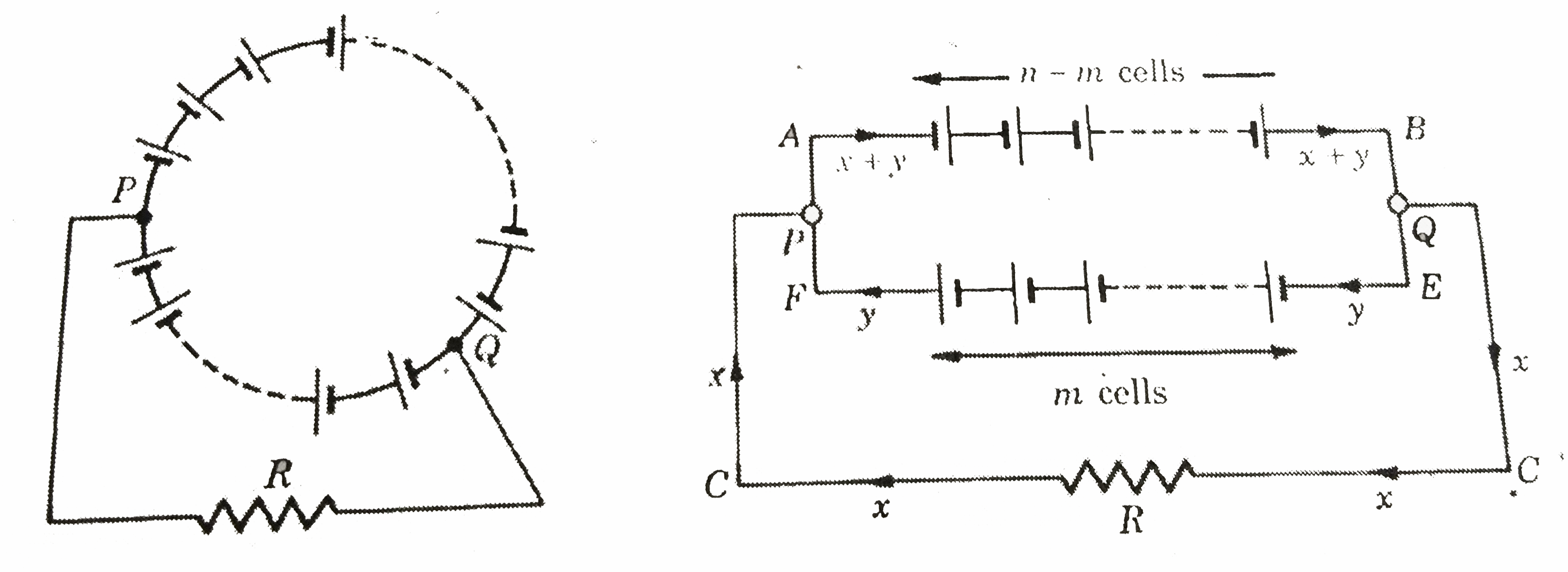In Q.36, the external resistance that must be connected is series with the main circuit so that the total current in the main circuit remains unaltered even when the galvanometer is shunted is
3663Ω
111Ω
107.7Ω
3555.3Ω
The correct Answer is:D
To solve the problem step by step, we need to determine the external resistance that must be connected in series with the main circuit so that the total current in the main circuit remains unaltered when the galvanometer is shunted.
Step 1: Understand the Problem
We have a galvanometer with a resistance G=3663Ω. A shunt resistance S is connected across the galvanometer such that 134 of the total current I passes through the galvanometer.
Step 2: Calculate the Shunt Resistance
From the information given, we can express the current through the galvanometer Ig and the current through the shunt Is:
- Ig=134I
- Is=I−Ig=I−134I=3334I
Using the formula for currents through the galvanometer and shunt, we can write:
IgIs=GS
Substituting the values:
134I3334I=GS
This simplifies to:
133=GS
Thus,
S=33G=33×3663Ω=12099Ω
Step 3: Calculate the Equivalent Resistance of the Shunted Galvanometer
The equivalent resistance Req of the galvanometer with the shunt is given by:
Req=G⋅SG+S
Substituting the values:
Req=3663⋅120993663+12099
Calculating the denominator:
3663+12099=15762
Now substituting back:
Req=3663⋅1209915762
Calculating Req:
Req≈107.7Ω
Step 4: Find the External Resistance R
To keep the total current in the main circuit unaltered, the total equivalent resistance of the circuit (including the external resistance R) must equal the resistance of the galvanometer G:
G=R+Req
Rearranging gives:
R=G−Req
Substituting the values:
R=3663−107.7≈3555.3Ω
Conclusion
The external resistance that must be connected in series with the main circuit is approximately 3555.3Ω.
We have a galvanometer with a resistance G=3663Ω. A shunt resistance S is connected across the galvanometer such that 134 of the total current I passes through the galvanometer.
From the information given, we can express the current through the galvanometer Ig and the current through the shunt Is:
- Ig=134I
- Is=I−Ig=I−134I=3334I
IgIs=GS
Substituting the values:
134I3334I=GS
This simplifies to:
133=GS
Thus,
S=33G=33×3663Ω=12099Ω
The equivalent resistance Req of the galvanometer with the shunt is given by:
Req=G⋅SG+S
Substituting the values:
Req=3663⋅120993663+12099
Calculating the denominator:
3663+12099=15762
Now substituting back:
Req=3663⋅1209915762
Calculating Req:
Req≈107.7Ω
To keep the total current in the main circuit unaltered, the total equivalent resistance of the circuit (including the external resistance R) must equal the resistance of the galvanometer G:
G=R+Req
Rearranging gives:
R=G−Req
Substituting the values:
R=3663−107.7≈3555.3Ω
The external resistance that must be connected in series with the main circuit is approximately 3555.3Ω.
Topper's Solved these Questions
- ELECTRICAL MEASURING INSTRUMENTSBOOK - CENGAGE PHYSICS ENGLISHCHAPTER - ELECTRICAL MEASURING INSTRUMENTSEXERCISE - Multiple Correct
7 Videos
- ELECTRICAL MEASURING INSTRUMENTSBOOK - CENGAGE PHYSICS ENGLISHCHAPTER - ELECTRICAL MEASURING INSTRUMENTSEXERCISE - Assertion-Reasoning
7 Videos
- ELECTRICAL MEASURING INSTRUMENTSBOOK - CENGAGE PHYSICS ENGLISHCHAPTER - ELECTRICAL MEASURING INSTRUMENTSEXERCISE - Subjective
18 Videos
- ELECTRIC POTENTIALBOOK - CENGAGE PHYSICS ENGLISHCHAPTER - ELECTRIC POTENTIALEXERCISE - DPP 3.5
15 Videos
- ELECTROMAGNETIC INDUCTIONBOOK - CENGAGE PHYSICS ENGLISHCHAPTER - ELECTROMAGNETIC INDUCTIONEXERCISE - compression type
7 Videos
Similar Questions
A 0.21 H inductor and a 12Ω resistance are connected in series to a 220 V, 50 Hz ac source.
The current in the circuit is
View SolutionA galvanometer of resistance 10Ω shows full scale deflection for current 100 mA. The resistance that needs to be connected in series with the galvanometer so that it can be used to measure potential difference in the range 0-100 V is (in Ohm):
View SolutionA galvanometer of resistance G is shunted by a resistance Sohm. To keep the main current in the circuit uncharged, the resistnace to be put in series with the galvonmeter
View SolutionA capacitor is charged so that it has a stored potential energy U and then connected in series with an identical, uncharged capacitor and a resistance. Until the current in the circuit becomes negligible, the total heat wasted in the resistance is H. The ratio HU is______.
View SolutionA galvanometer has a resistance of 3663Ω. A shunt S is connected across it such that (1/34) of the total current passes through the galvanometer. Then the value of the shunt is
View SolutionA galvanometer has a resistance of 3663Ω. A shunt S is connected across it such that (1/34) of the total current passes through the galvanometer. Then the value of the shunt is
View SolutionThere are n cells, each of emf E and internal resistance r, connected in series with an external resistance R. One of the cells is wrongly connected, so that it sends current in the opposite direction. The current flowing in the circuit is
View Solutionn' cells , each of emf 'e' and internal resistance 'r' are connected in a closed circuit so that the positive terminal of a cell is joined to the negative terminal of the next, as shown in figure. Any two points of the circuit are connected by an external resistance R. Find the current in R.

View SolutionA battery of emf 10 V and internal resistance 3Ω is connected to a resistor. If the current in the circuit is 0.5 A, what is the resistance of the resistors ? What is the terminal voltage of the battery when the circuit is closed ?
View SolutionA resistance R Ohm is connected in series with capacitance C Farad value of impedance of the circuit is 10 Ohm and R = 6 Ohm so, find the power factor of circuit
View Solution
